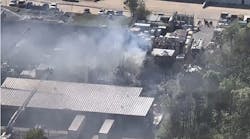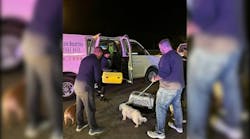Uprighting a loaded cement mixer or lifting the rear of a loaded van trailer are everyday tasks for heavy recovery operators. Place someone who is injured and trapped in a car under such a vehicle and a challenge begins.
While heavy recovery operators may easily overcome this challenge, it may prove formidable for fire-rescue responders. This challenge may be a matter of life and death for the victims of the accident and prove dangerous to emergency responders.
A "5-Step Discipline" provides a guideline for success regarding overturns or underrides. An overview of this discipline is in the information that follows. It is an effort to provide fire-rescue responders with a simple list of steps to follow when faced by such an intimidating sight.
STEP 1. Identify the Cargos Of All Vehicles Involved
Many training programs offer specific information regarding cargo identification and the responder is urged to complete a hazardous materials training program in order to be prepared. Sources of information available on scene are: shipping documents, placards, container shapes/sizes/colors/labeling, the vehicle operator, the vehicle owner and the shipper. Certainly this affects the safety of all involved and is the first task performed.
Hazardous material releases are best handled by appropriately trained and equipped personnel. Also included in this step is mitigation of hazards involved with the vehicles themselves. This is common practice among responders to vehicle collisions and includes: scene assessment, fire/fuel hazards, de-energizing the electrical system, searching for victims and calling for additional resources. Typically, big rigs carry 100 to 150 gallons of diesel fuel in each tank. Usually, there are two tanks mounted alongside the tractor known as "saddle tanks." It is common for at least one tank to rupture during a substantial collision, perhaps both. Responders should understand the characteristics of the fuel(s) involved and be prepared to mitigate the associated hazards.
An undeployed supplemental restraint system (SRS) also presents a problem, generally in the smaller vehicle in an overturn/underride situation. Promptly de-energizing the electrical system in all vehicles involved is an important task. Big rigs typically have a bank of batteries parallel wired to offer greater starting amperage. The location of the battery banks varies according to rig. There is no definite location of battery banks for each rig. The battery cables of big rigs are larger than those of cars, nearly the size of 00-gauge wire. The cables may be disconnected at the terminal or double cut using a cutting tool. The preferred cutting tool is a hand-held ratcheting cable cutter such as used by industrial electricians.
Once an assessment of the scene is completed, additional resources are usually requested. Incidents involving big rigs versus smaller vehicles may require such resources as heavy wreckers, urban search and rescue (USAR) trained responders and their gear, heavy rescue squads and extended-incident traffic-control devices. Ideally, these resources will be responding on the initial alarm. Pre-planning for the dispatch and response of special resources is fundamental when faced with big-rig collisions.
STEP 2. Stabilize the Larger Vehicle
This is critically important to increase safety for responders and prevent further injury to victims. Generally, fire-rescue responders attempt to accomplish this using timber cribbing and strut systems. While these tools are useful, they may not provide the support needed due to the construction of the larger vehicle or the damage inflicted on it during the accident. The optimum in this circumstance is using the heavy wrecker as a stabilizing tool.
Typically, there is sufficient force and tools needed to perform this task on a heavy wrecker. Moreover, it is important that fire-rescue responders realize the limitation of their equipment in this type of collision. They must understand the weight involved, construction methods, and materials of various trucks and trailers in order to appreciate these limitations. Without knowing the weight (resistance) imposed on the stabilization gear, it is possible to exceed the working load limit (WLL). Responders should be able to calculate the loads (resistances) in order to operate safely. Generally, vertical weight is calculated using the industry-accepted value of axle weight values: thin-profile steering tires of a Class 8 big rig (tractor-trailer) carry a front-axle weight rating of 12,000 pounds, larger front "balloon" tires are calculated using a front-axle weight of 25,000 pounds, and the drive axles of the tractor and trailer axles are calculated at 20,000 pounds each. If the axles are to be supported vertically, as in the case of an underride, these axle weight ratings are useful in determining the amount of stabilization needed.
When an object is lifted vertically, 100% of the weight is assumed by the lifting gear. Using a law of physics, "For every action there is an equal and opposite reaction" or simply "force pairs" responders can calculate the total amount of stabilization capacity needed. For example, consider a car that is involved in an underride with the front steering axle of a big rig. The big-rig axle weight rating is 12,000 pounds and the car is trapped underneath, which has lifted the front axle vertically. Thus, a total of 12,000 pounds of stabilization support is needed. Conversely, the lifting force required is also 12,000 pounds.
With an overturn of a big rig onto a smaller vehicle, the calculations are performed differently. For example, a fully loaded tractor-trailer (80,000 pounds) has overturned onto an auto. Responders will be stabilizing one side of the truck nearest the car, perhaps allowing the total uprighting prior to performing extrication. If the big rig were at zero degrees from horizontal (flat on the surface with no car involved), responders would only be lifting half of the overall weight which is 40,000 pounds. Further calculations are made using this figure as it becomes the maximum amount to be lifted.
As the horizontal angle of the big rig increases, the weight becomes less due to the application of the Class 2 lever principle and movement of the center of gravity (COG). At 30 degrees from horizontal, the lifting/stabilization would require 50% of the maximum of 40,000 pounds, equaling 20,000 pounds. These are recovery industry-accepted values that are useful during extrication operations. Obviously, they could be affected by certain cargos (liquids) and the way in which they are positioned after collision.
Once a weight (resistance) is known, stabilization gear can be applied. Typically, the best tools include timber cribbing and strut supports. Struts may be used effectively with big-rig incidents due to the vertical stabilization height needed and weights imposed upon them. The use of chain slings with struts is also effective. A minimum of Grade 80 (or greater) chain should be used during extrication operations. Preferably, half-inch-link-diameter chain is used to maximize the support provided by the strut. Generally, this requires the use of alloy steel strap shackles with strut attachments. A basket hitch can be employed using two struts and chain slings, which doubles the single-leg capacity of the chain sling if the "legs" of the sling are at 90 degrees to the load.
Caution should be exercised so as to not create a sharp bend in the chain. If a chain sling passes around a 90-degree bend in which the bend radius is less than two times the link diameter, the WLL of the chain sling is decreased by 50%. This can be avoided by "padding" the bend using cribbing.
STEP 3. Lower the Smaller Vehicle
Typically, this isn't possible, as the heavier vehicle has crushed the smaller one to some extent. Simply deflating the tires may provide a few inches of lowering. Generally, the suspension of the smaller vehicle will compress on heavy loading, creating an added problem during the lifting of the larger vehicle. As the big rig is lifted, the suspension will relax, thus letting the smaller vehicle rise. Actually, this will decrease the total amount of lift gained nearly five or six inches.
Suspension compression may be helpful, and can be accomplished using a ratcheting load binder strap (minimum of two-inch width). For example, when the front of a car has struck the rear of a tractor-trailer, the strap is connected to the front wheels of the car and the strap tightened. As the larger vehicle is lifted, the suspension will remain compressed. The larger vehicle must be lifted high enough to provide clearance for appropriate rescue measures.
Alternative extrication techniques may be performed; i.e., trunk tunneling. Perhaps this technique will be of benefit and offer the opportunity to maintain axial spinal alignment. Responders should learn and frequently practice alternative techniques for such incidents involving overturns/underrides.
STEP 4. Lift the Larger Vehicle
This is best accomplished with a heavy wrecker and its associated equipment. When lifting such weight, it is vital that fire-rescue responders understand their limitations when using common extrication equipment. Responders are urged to seek out training providing details of lifting physics, timber cribbing capacities, big-rig anatomy, rigging and heavy-lifting operations. Only with a thorough knowledge of this information will they understand their capabilities.
As the vehicle is lifted, it should be fully supported by equipment that is within its WLL. Herein lies the benefit of timber cribbing, vertical strut systems and heavy wreckers. Obviously, continuous observation must be provided for any lifting or uprighting operation to increase the safety for all involved. The area surrounding the vehicles should be under constant surveillance by responders who can sound a command to halt the lift. This command must be established prior to any lifting and understood by everyone on scene, as such an operation may be lifting and stabilizing several thousand pounds.
Responders are urged to train with local heavy-duty towing and recovery operators prior to any incident. It is important to understand the capabilities and limitations of the heavy wreckers as well. In fact, the ideal circumstance is to arrange for the response of a heavy wrecker on a first-alarm assignment to an overturn/underride incident. Unless it is a recognized emergency vehicle, a heavy wrecker must obey all traffic laws and regulations.
Cell phone pictures from various angles of the collision can be forwarded to incoming heavy units. This allows an opportunity to begin assessment prior to arriving for the operators. An area large enough for the heavy wrecker to operate should be provided on scene. A responder should be assigned to accompany the wrecker operator and facilitate the lifting operation. During the actual lifting operation, the lifting manager should be in constant voice, visual or touch contact with the wrecker operator.
STEP 5. Separate the Vehicles and Extricate the Victims
Although controversial, this step provides increased safety for victims and emergency responders. Depending on the type of big rig, it may be safer to upright the rig rather than operate under it. Once the lift has begun, it is safer to continue until the overturned big rig is uprighted. After lifting the larger vehicle, the smaller one is attacked similarly to a common extrication problem. It is inadvisable and dangerous for anyone to work beneath a suspended load. A thorough knowledge of timber cribbing, struts and heavy rigging is paramount to provide safety for all involved.
This article features an overview of the "5-Step Discipline." The Big Rig Rescue program provides much more information and fosters a cooperative working relationship among heavy recovery operators and fire-rescue responders. For details, contact the author at [email protected] or P.O. Box 4324, Asheboro, NC 27204.
BILLY LEACH Jr. has been involved in emergency services since 1976, combining career and volunteer experience. He serves as the developer and senior presenter for Big Rig Rescue and conducts training in vehicle rescue. Leach is a co-author of the textbook Big Rig Rescue, on heavy-truck anatomy and extrication. He may be contacted at [email protected] or P.O. Box 4324, Asheboro, NC 27204.





